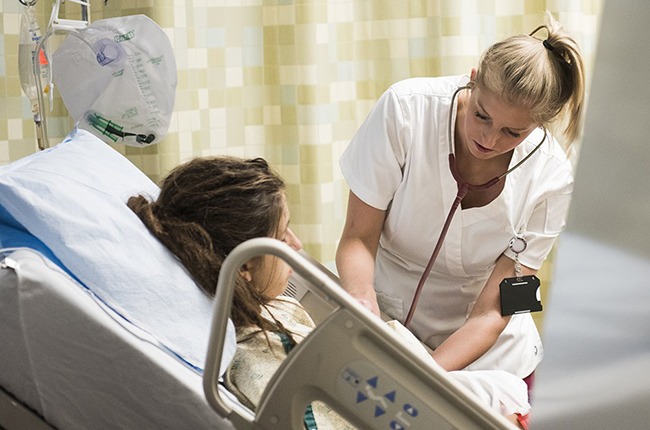 January is Cervical Cancer Awareness Month.
January is Cervical Cancer Awareness Month.
Each year, nearly 12,000 women are diagnosed with cervical cancer, but Shelley White-Corey, RNC, WHNP, CNE, clinical assistant professor at the Texas A&M College of Nursing, says that the cancer is treatable when caught early, and there are ways to lower your risk.
“Cervical cancer is when cells on the cervix—the mouth of the uterus—begin to change,” White-Corey said. “They call it becoming dysplastic.” Dysplasia is disordered growth of the epithelium, which is the outer layer of skin cells on the cervix.
Cervical cancer is typically caused by the human papillomavirus (HPV), a virus transmitted through skin-to-skin sexual contact. There are over 100 strains of HPV, some of which can cause genital warts and others that can lead to cancer of the cervix, anus and even throat. The steps to prevent HPV and, in turn, cervical cancer are simple.
Get the HPV vaccine
Two forms of the vaccine, Gardasil and Cervarix, protect against HPV types 16 and 18, which cause approximately 70 percent of cervical cancer cases. A newer vaccine, Gardasil 9, protects against seven more strains of HPV, thus covering those that lead to about 80 percent of cervical cancer. These vaccines are recommended in two doses for both boys and girls between the ages 11 to 14 but can be administered until the age of 26. “It’s preferable that young people are vaccinated before they become sexually active,” White-Corey said, “but even if they are already active, they can still get the vaccine to protect against a strain of HPV that they have not yet come into contact with.”
“Too often parents chose not to allow their children to be vaccinated because they fear that it could encourage promiscuity or believe the vaccine isn’t safe,” White-Corey added. “Those are irresponsible misconceptions with no substantiating evidence.”
Get regular Pap smears
Pap smears are a part of a routine pelvic exam by a health care provider, who will examine the cervix and scrape cells from its surface to be tested at the lab with a cytology screening.
Pap smears are recommended for all women, starting at age 21. “The recommendation used to be to begin screening when a woman became sexually active, even in her teens,” White-Corey said. “However, scientists discovered that too many unnecessary cervical procedures for teen women were associated with preterm birth.” Scientists also discovered that if a teen woman contracted HPV, her body was often able to heal the infection without treatment.
Women in their 20s should be screened every three years, and women from age 30 to 65 should be screened and tested for HPV every five years. Cervical cancer is slow to grow, so regular screenings should catch any cell changes before they become cancerous. The median age for women diagnosed with cervical cancer is age 49. It is partly due to the slow-growing nature of the cancer that screening is not recommended for women over 65 years old.
The disease is not one of heterosexual women alone. Women with female partners can also contract HPV, potentially leading to cervical cancer. “Many lesbians will not get their routine Pap smears because they think they can’t get the cancer or are afraid of being judged,” White-Corey said, “but it’s really important for them to go get checked as well.”
Practice safe sex
Limiting the number of sexual partners and using protection, like condoms, can significantly curb a person’s exposure to HPV and reduce the risk of cervical cancer.
“One major fact we know about cervical cancer: the number one cause is HPV, and the best way to get HPV is to have a number of sexual partners,” White-Corey said. “We know that nuns tend not to get cervical cancer because they’re abstinent.”
Don’t smoke
Smoking is associated with an increased risk for cervical cancer. Experts are not definitively sure why, but some believe the carcinogens ingested from smoking tobacco may impair the body’s ability to fight HPV infections.
Quitting tobacco will not entirely remove health damage from smoking, but each day without tobacco is found to help alleviate the risks of many cancers. One of every three cancer deaths in the United States would not occur if no one smoked, according to the Centers for Disease Control and Prevention.
Be honest about your health and sexual history
Early signs of cervical cancer may include unusual vaginal bleeding or discharge, pain during intercourse or pain in the lower belly or pelvis. “You get cervical cancer by having a lot of partners, not practicing safe sex and not getting your Pap smears,” said White-Corey. “Be honest with your health care provider about your health and sexual history. Because of the simple steps it takes to prevent cervical cancer, the very slow growth rate of the cells and the improvements for treatment, few women should ever die from it.”
https://today.tamu.edu/2016/11/28/could-mitochondria-hold-the-answer-to-regulating-cancer-growth/
#####
This story originally appeared on Vital Record.





